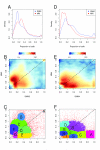Intraclonal heterogeneity is a critical early event in the development of myeloma and precedes the development of clinical symptoms
- PMID: 23817176
- PMCID: PMC3916874
- DOI: 10.1038/leu.2013.199
Intraclonal heterogeneity is a critical early event in the development of myeloma and precedes the development of clinical symptoms
Abstract
The mechanisms involved in the progression from monoclonal gammopathy of undetermined significance (MGUS) and smoldering myeloma (SMM) to malignant multiple myeloma (MM) and plasma cell leukemia (PCL) are poorly understood but believed to involve the sequential acquisition of genetic hits. We performed exome and whole-genome sequencing on a series of MGUS (n=4), high-risk (HR)SMM (n=4), MM (n=26) and PCL (n=2) samples, including four cases who transformed from HR-SMM to MM, to determine the genetic factors that drive progression of disease. The pattern and number of non-synonymous mutations show that the MGUS disease stage is less genetically complex than MM, and HR-SMM is similar to presenting MM. Intraclonal heterogeneity is present at all stages and using cases of HR-SMM, which transformed to MM, we show that intraclonal heterogeneity is a typical feature of the disease. At the HR-SMM stage of disease, the majority of the genetic changes necessary to give rise to MM are already present. These data suggest that clonal progression is the key feature of transformation of HR-SMM to MM and as such the invasive clinically predominant clone typical of MM is already present at the SMM stage and would be amenable to therapeutic intervention at that stage.
Figures




References
-
- Palumbo A, Anderson K. Multiple myeloma. N Engl J Med. 2011;364(11):1046–60. - PubMed
-
- Kyle RA, Therneau TM, Rajkumar SV, Offord JR, Larson DR, Plevak MF, et al. A Long-Term Study of Prognosis in Monoclonal Gammopathy of Undetermined Significance. New England Journal of Medicine. 2002;346(8):564–569. - PubMed
-
- Criteria for the classification of monoclonal gammopathies, multiple myeloma and related disorders: a report of the International Myeloma Working Group. British journal of haematology. 2003;121(5):749–57. - PubMed
-
- Morgan GJ, Walker BA, Davies FE. The genetic architecture of multiple myeloma. Nat Rev Cancer. 2012;12(5):335–48. - PubMed
Publication types
MeSH terms
Grants and funding
LinkOut - more resources
Full Text Sources
Other Literature Sources
Medical

